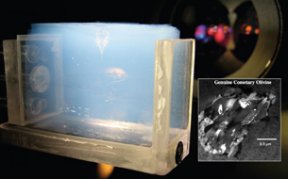The first study of comet dust brought to Earth by a spacecraft has revealed several minerals that could have formed only at the fiery temperatures close to the sun or another star. The findings come as a surprise because comets, frozen relics of the early solar system, were born beyond the orbit of Neptune and spend most of their time there.

Don Brownlee of the University of Washington in Seattle and his colleagues base their findings on the first particles they’ve examined from the Stardust craft, which sped within 236 kilometers of the nucleus of Comet Wild 2 in 2004 and collected material expelled by the frozen body. In January, a canister of the samples parachuted to a Utah desert (SN: 1/21/06, p. 37: Available to subscribers at Pay Dirt: Cometary dust collector comes home).
The scientists have sliced a few of the micrometer-size grains into hundreds of samples. The grains include the green silicate crystal olivine as well as minerals rich in titanium and aluminum. Olivine forms at temperatures from 900 to 1,100 kelvins, while the other minerals require a temperature of about 1,400 K.
The results suggest that Wild 2 and perhaps other comets are amalgams of some of the hottest and coldest materials in the solar system, Brownlee said last week at the annual Lunar and Planetary Science Conference in Houston.
Two leading theories may account for the high-temperature materials in the comet, he notes. According to one scenario, the particles formed in the inner solar system when the sun, now 4.6 billion years old, was less than 10 million years of age.
At that time, the sun would have been swaddled by a disk of gas, dust, and ice, the birthplace for planets. Olivine and other minerals could have formed within the innermost part of the disk and then been pushed out by the sun’s wind to the solar system’s chilly outskirts. There, the grains could have been incorporated into fledgling comets.
The other theory suggests that the minerals were forged around the hot, inner region of another star that happened to reside near the young sun. Wind from that star could have expelled the material into the solar system’s icy periphery.
To determine which theory is correct, researchers now plan to measure the relative abundance of isotopes, such as oxygen-16, -17, and -18, within each of the high-temperature grains. If the grains are native to the solar system, their isotopic composition ought to be identical to that of the sun.
Wild 2 isn’t the only comet known to contain high-temperature minerals. Remote observations of material excavated when a spacecraft fired a projectile into Comet Tempel 1 last July 4 (SN: 9/10/05. p. 168: Deep Impact) revealed that this frozen body also contains olivine, notes Casey Lisse of the Johns Hopkins Applied Physics Laboratory in Laurel, Md.
But scientists could observe this impact only from afar. By bringing back samples of Comet Wild 2, Stardust “is now giving us the ground truth” about comets and confirming the remote studies of Tempel 1, Lisse says.







